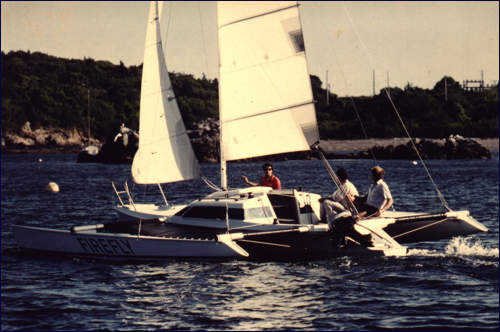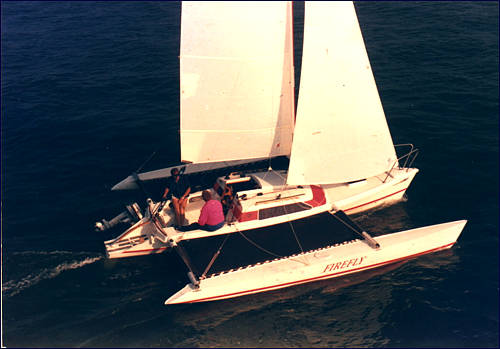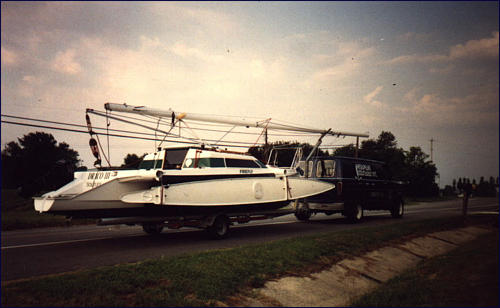
|
Back in 1986-87, Chesapeake Catamaran was searching throughout Europe for production multihulls that might be marketable in the USA (something other than the Prouts and Catalacs of the time). We settled on two, the Fountain/Pajot cats from France, and the Dragonfly tri from Denmark. We imported a sample of each and embarked on a concentrated marketing campaign. The smaller trailerable Dragonfly tri was very well received. The product, along with our aggressive marketing, produced 2 deposits before the first boat ever arrived in the US! Subsequent exposure in the fall and spring shows resulted in another 10 deposits for this design. We had picked a winner! Regrettable the manufacture was totally unable to supply those boats. His European orders had increased dramatically, and he could not/did not physically expand his production capacity to meet our needs, nor those of his other new importer in Canada. I had predicted such a possibility during my original talks with the manufacturer, but was assured that this was not a problem should we receive orders. Nine months of negotiations still resulted in no boats for our market, nor even a hope for any. Our frustration and that of the Canadian gentleman grew exponentially. With half the deposits still on board, we set about the project to redesign the boat for the North American market. We incorporated numerous changes based on both our considerable past experiences with multihull craft, Brian Eiland's previous sailing design studies, and very importantly, the public's feedback responses. We had often encouraged our manufactures to listen to their potential client, even while they tried to sell them their product. A number of our modifications in redesign were a direct result of listening to the public feedback gained at the numerous boat show exhibits and demonstration sails:
There were numerous other detail changes that were made, and a number of others in the planing stages. Wherever possible we retained the same looks of the original boat as it had always received admiring compliments, and we had invested a lot of marketing time and money already. We really felt that our new Firefly 26 had the potential to become the J-24 of multihulls, particularly with an initial strong marketing program through our 50+ beach catamaran dealers at the time (ref our archive letter to those dealers). The F-27 trailerable trimaran program was developing concurrently, and we felt their massive print advertising campaign could only help us as well; plus! we had a distribution/dealer program in place that they were not considering at that time. Unfortunately this was all not to be. Several financial hiccups and finally a partnership disillusionment killed the project. We had built six boats including the prototype. And they were all fun to sail!! A couple of photos are included below. For additional drawings, photos, etc., please visit the archives
|
|
|
|
|
|
Observations. After over 18 years involvement with the sailing and selling of trailerable multihulls including our Firefly tri and over a hundred Stiletto cats (23,27,& 30'), I would offer a few general observations. At
a boat length of less than 30', I believe the trimaran configuration
is the superior form for a small cruising multihull. I liken
them to a small monohull with training wheels. Their accommodations
are superior to those of the long slender spaces of a catamaran
at this size. The wives were quick to point this out. Submerging
the amas (training wheels) under sail provided an element of predictability
as to when the vessel might be overpowered. And there's some security
of being located in a central cockpit as opposed to crossing
over a trampoline onto which one is setting. At 30 to 35 feet I would call it a draw. There are reasonable good designs of both at this size. Above 35' the catamaran type really starts to shine as a cruising design. The wing bridge deckhouse becomes usable space, and quiet a nice one at that. And the hulls are now large enough for nice staterooms that are separate and distinct from both each side, and the shared saloon area With all things considered, including building cost, it's tough to beat a cat at these larger sizes. Big ocean racing multihulls are a totally different breed. As we saw with the original Formula 40 boats, the tri's are taking over. Look at those fantastic 60 footers, and the many new developments with each new design. It will be interesting to see what designs might appear for the next unlimited RACE around the world. Personally, I'm still betting on a catamaran design for this RACE. But if I were looking for a big trimaran design, I'd be seeking out Nigel Irens or one of several French design teams. |
|


